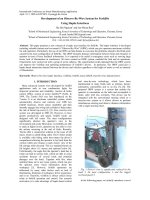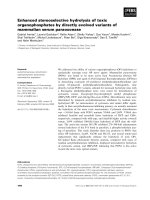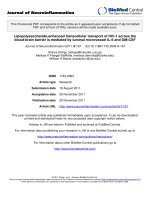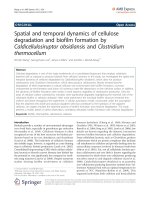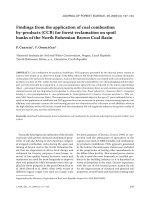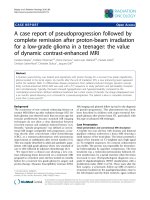Enhanced flame resistance of cellulose aerogel by ammonium polyphosphate for heat insulation
Bạn đang xem bản rút gọn của tài liệu. Xem và tải ngay bản đầy đủ của tài liệu tại đây (744.88 KB, 8 trang )
Nghiên cứu khoa học công nghệ
Enhanced flame resistance of cellulose aerogel
by ammonium polyphosphate for heat insulation
Nguyen Tan Luon1,2, Phan Le Bao1,2, Do Nguyen Hoang Nga1,2, Mai Thanh Phong1,2,
Le Van Thang2,3, Le Anh Kien4, Le Thi Kim Phung1,2,*
1
Faculty of Chemical Engineering, Ho Chi Minh City University of Technology (HCMUT), 268 Ly
Thuong Kiet Street, District 10, Ho Chi Minh City, Vietnam;
2
Vietnam National University Ho Chi Minh City, Linh Trung Ward, Thu Duc District, Ho Chi Minh City,
Vietnam;
3
Faculty of Materials Technology, Ho Chi Minh City University of Technology (HCMUT), 268 Ly
Thuong Kiet Street, District 10, Ho Chi Minh City, Vietnam;
4
Institute for Tropical Technology and Environmental Protection, 57A Truong Quoc Dung Street, Phu
Nhuan District, Ho Chi Minh City, Vietnam.
*Corresponding author:
Received 25 Oct 2022; Revised 14 Nov 2022; Accepted 14 Dec 2022; Published 20 Dec 2022.
DOI: />
ABSTRACT
Cellulose aerogels are a potential candidate for heat insulation, but one of their drawbacks is
high flammability hindering their applications in practice. This study synthesized cellulose
aerogels from microfibrillated cellulose fibers (MFC) extracted from discarded pineapple
leaves. The procedure started with simply mixing the extracted fibers with polyamide amineepichlorohydrin (PAE) as a chemical crosslinker and ammonium polyphosphate (APP) (10-20%)
as a green and effectively flame-resistant additive, followed by freeze-drying. The produced
aerogels are characterized in terms of their morphology, thermal stability and conductivity, and
flame resistance via advanced and standardized methodologies including Scanning Electron
Microscopy (SEM), Thermogravimetric Analysis (TGA), thermal conductivity measurement by a
heat flow meter, and UL94 horizontal burning test. The flame-resistant cellulose aerogels exhibit
ultra-low density (25.5-26.8 mg/cm3), high porosity (98.0-98.2%), excellent heat insulation
(35.9-36.7 mW/m۰K), and are completely flame-resistant. In addition, the varied APP content
(10-20%) shows little effect on the density, heat conductivity, and thermal stability of the flameresistant cellulose aerogels in comparison with that of the neat cellulose aerogel. Based on the
findings, the synthesized flame-resistant cellulose aerogels are considered a promising bio-based
heat insulation material.
Keywords: Microfibrillated cellulose; Pineapple leaves; Aerogel; Thermal insulation; Flame resistance.
1. INTRODUCTION
Among the most promising porous materials of the 21st century, aerogels recently have many
potential applications in various fields. They have an extremely low density (1.1–500.0 mg/cm3),
high porosity (up to 99.8%), huge specific surface area (10–2000 m2/g) [1], low thermal
conductivity (e.g. as low as 13 mW/m۰K for silica aerogel) [2], and high noise reduction
coefficient (NRC) (e.g. cellulose aerogels can achieve NRC of 0.52) [3]. Moreover, their surface
can be modified by chemical reactions to produce a wide range of surface-active properties.
Based on their outstanding properties, aerogels are widely applied for adsorption, energy storage,
heat insulation, sound absorption, etc. Nowadays, many materials, such as polymers,
carbonaceous materials, metal/metal oxides, silica-based materials, etc., have been used for
fabricating aerogels [1]. Noticeably, biomass/biopolymer aerogels have recently been gaining
more and more popularity due to their natural abundance, cost-efficiency, eco-friendliness, and
biodegradability. The major raw materials for the synthesis of biomass-based aerogels are
agricultural waste (e.g., sugarcane bagasse, coconut coir, pineapple leaves, rice straw, etc.) or byTạp chí Nghiên cứu KH&CN quân sự, Số Đặc san Viện Nhiệt đới Môi trường, 12-2022
15
Hóa học & Mơi trường
products from the food processing sector (e.g., crab, prawns, and shrimp shells, etc.). Those
residues can cause many environmental problems via burning, landfilling, or discharging directly
into the environment, which releases many pollutants. In Vietnam’s agricultural sector, pineapple
is one of the largest fruit harvests, with a total cultivated area in 2019 of 39,158 ha [4].
Accompanied by substantial pineapple production, the amount of waste from pineapple trees in
Vietnam, including leaves, peels, seeds, and unused flesh, is also considerable, over 1 million
tons annually [5]. However, the fibers produced from pineapple leaves are valuable due to their
high proportion of cellulose (approx. 36%) and high mechanical strength (compression module
from 34.5 to 82.5 GN/m2, tensile strength from 413 to 1627 GN/m2) [6, 7]. Therefore, pineapple
fibers are favorable for fabricating cellulose-based ultra-light aerogel. In 2020, Do et al.
synthesized aerogels from pineapple fibers which exhibit ultra-low density (13–33 mg/cm3), high
porosity (above 96%), great Young’s modulus (1.64–5.73 kPa), low thermal conductivity (30–40
mW/m۰K), and high NRC (approx 0.52) [3].
Nowadays, the demand for transport, refrigeration systems, domestic appliances, modern
energy-efficient building construction, etc., requires thermal insulation materials. Because of
their low density (below 350 mg/cm3), high porosity (84.0-99.9%), low thermal conductivity
(23.0-75.0 mW/m۰K), and their advantages related to environment and economy, cellulose
aerogels are potential candidates for those applications [8]. The thermal conductivity of cellulose
aerogels is strongly associated with their density and porosity. As the density decreases and the
porosity rises, this will lead to a downturn in the heat conductivity of cellulose aerogels [9].
Compared with cellulose-based aerogels, microfibrillated cellulose (MFC) aerogels express a
lower density (29.1–36.1 mg/cm3) and higher porosity (97.4–98.0%) [10]. This is the sound
foundation for a lot of recent research focusing on developing thermal insulation materials from
MFC. However, the limiting oxygen index (LOI) of pure cellulose is only 19% which means
they are highly inflammable [11]. That is one of the major drawbacks of aerogels fabricated from
MFC. This problem could be addressed by either adding flame-retardant additives (e.g., sodium
bicarbonate (NaHCO3), ammonium polyphosphate (APP), etc.) or in-situ formation of flameretardant agents (e.g., silica (SiO2), magnesium hydroxide (Mg(OH)2), etc.) with the expectation
of minimal effect on insulation properties as well as thermal and mechanical stability of aerogels
[9, 11, 12]. In 2017, Li and Wang combined the polymerization of dopamine and hydrolysis of
organosilicon in cellulose nanofiber (CNF) suspension, followed by freeze-drying. The obtained
aerogels expressed a self-extinguishing property, low density (15.1–28.5 mg/cm3), and desirable
compression strength (76.6–135.8 kPa) but high thermal conductivity values (~46 mW/m۰K)
[12]. Muhammad Farooq et al. (2017) fabricated CNF aerogels by integrating sodium
bicarbonate (SBC) as the fire retardant without affecting the thermal conductivity of the aerogels
(approx. 28 mW/m۰K). The minimum burning velocity of those resulting aerogels was 0.20
cm/s at 40 wt% of SBC in comparison with 5.84 cm/s of pure CNF aerogels [12]. This method
is low-cost, industrially efficient, and environmentally friendly, but the obtained aerogels still
get burned despite the high proportion of SBC. Among the flame-retardant additives,
ammonium polyphosphate (APP) captures a great deal of attention because of its high flameretardant character, eco-friendliness, no hazardous effects on humans, and cost-effectiveness
[8]. In 2019, Huang et al. improved the flame-retardant property of polyvinyl alcohol
(PVA)/CNF aerogel by microencapsulated APP (5.3-13.3 wt% of dry CNF). Although the
material became self-extinguished, their density and thermal conductivity rose significantly to
60.0 mg/cm3 and 41.2 mW/m۰K, respectively, compared to the non-microencapsulated APP
aerogel, at 47.0 mg/cm3 and 38 mW/m۰K in that other [13]. In 2021, MinYi Luo et al. used
APP to enhance the anti-combustion character of PVA-based aerogels, which are crosslinked
by chitosan (CS) and boric acid (H 3BO3). The time to ignition (TTI) of the PVA-based
aerogels was up to 156 s compared to 66 s of those having APP (15.6-46.9% of PVA). The
16
N. T. Luon, …, L. T. K. Phung, “Enhanced flame resistance of … for heat insulation.”
Nghiên cứu khoa học công nghệ
aerogels exhibited high thermal conductivity (approx 87.9 mW/m۰K) as well as many
chemicals were included in the synthesis process [14].
Therefore, in this study, heat-insulating cellulose aerogel has been fabricated for the first time
from abundant pineapple leaves and polyamide amine-epichlorohydrin (PAE), a common green
crosslinking agent mainly used in the papermaking industry via a simple procedure. APP with
different contents (10-20 wt%) was added to cellulose aerogel to create a flame-resistant aerogel
with marginal change in its thermal conductivity. The density, porosity, morphology, thermal
conductivity and stability, and burning velocity of the obtained aerogels were examined by
advanced and standardized methods.
2. EXPERIMENTAL
2.1. Materials
Pineapple leaf (PL) fibers were supplied from Nghe An province, Vietnam. Sodium
hydroxide (NaOH, purity 96%), ammonium polyphosphate (APP), hydrogen peroxide (H 2O2, 40
wt%), and sulfuric acid (H2SO4, 98 wt%) were purchased from Xilong Scientific Co., Ltd.,
China. Polyamide amine-epichlorohydrin (PAE) was obtained from Shandong Bluesun Chemical
Co., Ltd., China. All solutions were prepared in reverse osmosis (RO) water.
2.2. Preparation of microfibrillated cellulose (MFC)
Raw pineapple leaves were grounded to fine powders (50 mesh size) and then treated with a 3
wt% NaOH solution with a liquid-to-solid mass ratio of 20:1 for 2 h, at 80 °C. The alkaline
treatment was repeated three times. The pulps were then rinsed with RO water until neutral pH.
After that, the dry obtained solid was bleached with a mixture of 10 wt% H 2O2 and 1 wt% NaOH
solution (ratio of 1:1 in volume) at a liquid-to-solid mass ratio of 20:1 for 1 h, at 80 °C. Finally,
the cellulose-rich pulp, denoted as BPL, was recovered after filtration, rinsing with RO water
until pH-balanced, and drying in an oven at 80 °C overnight. The solid recovery for BPL from
raw pineapple leaves reached approximately 44.6%.
BPL was hydrolyzed in a 40 wt% H2SO4 solution at a liquid-to-solid mass ratio of 20:1 for 3
h, at 45 °C. This step was terminated by adding RO water, and the obtained mixture was settled
down over time. The upper layer of water separated from the suspension was removed
periodically, introduced fresh water until the suspension reached neutral pH. Finally, the
obtained mixture was homogenized for 2 h at 15000 rpm to achieve microfibrillated cellulose
named MFC. H2SO4 and NaOH from wastewater could be recovered by distillation and
crystallization for reusing.
2.3. Preparation of flame-resistant cellulose aerogel
Firstly, suspensions of MFC (1 wt%) and BPL (1 wt%) were mixed with a weight ratio of 3:1
to achieve a cellulose suspension (1 wt%). After that, PAE (80 wt% of dry cellulose) and APP
(10-20 wt% of dry cellulose) were introduced to the re-prepared cellulose suspension and
vigorously stirred for 15 min. The obtained mixture was then refrigerated for 24 h before
lyophilizing using a Toption TPV-50F lyophilizer under the vacuum condition for 48 h. The final
flame-retardant cellulose aerogel was achieved after heat annealing in an oven for 3 h, at 120 °C.
2.4. Characterization
The bulk density of each aerogel sample is calculated as a ratio of its weight and volume. The
porosity (φ (%)) is determined using the bulk density (
(mg/cm3)) and the average skeletal
3
density of components ( (mg/cm )) as shown in Eq.1:
1
a
100%
b
Tạp chí Nghiên cứu KH&CN quân sự, Số Đặc san Viện Nhiệt đới Môi trường, 12-2022
(1)
17
Hóa học & Mơi trường
(mg/cm3)) of the composite was determined using Eq.2:
The average skeletal density (
b
1
Wi
(2)
i
Where
and
are respectively mass fraction and skeletal density of each component in
the material. The skeletal density of MFC, BPL, PAE and APP are assumed as 1.46, 1.35, 1.15,
and 1.90 g/cm3, correspondingly [5].
Field Emission-Scanning Electron Microscope (FE-SEM, Hitachi S4800) was used to
investigate the morphology of the aerogel samples. Each sample was coated with a thin layer of
Pt before testing, and the test was conducted at an acceleration voltage of 10 kV. A TGA
analyzer (LINSEIS DSC PT 1600) was applied to evaluate the thermal stability of the aerogels.
The samples were heated from 30 °C to 700 °C at a heating rate of 5 °C/min in the air flow rate
of 20 mL/min. The thermal conductivity of the aerogels was examined at room temperature by
using the HFM-100 Heat Flow Meter (Thermtest Inc., Canada). The procedure adapted from the
UL-94 horizontal test was applied to examine the flammability of the samples. The standard
tested samples were around 1.3 cm wide, 6 cm long, and 1 cm thick. They were ignited for 3 s
before freely flaming. A digital camera was used to record the whole combustion process, and
the combustion velocity (V (mm/s)) was determined by the following equation:
V
L
t
(3)
In Eq.3, L (mm) is the burned length, and t (s) is the time of burning.
3. RESULTS AND DISCUSSION
3.1. Density and porosity of cellulose aerogels
50
99.0
Density (mg/cm3)
40
98.1
98.2
98.1
98.0
98.5
98.0
26.8
30
24.4
25.5
25.9
97.5
20
97.0
10
0
Porosity (%)
Density
Porosity
96.5
0
10
15
20
96.0
APP content (%)
Figure 1. Density and porosity of cellulose aerogel as a function of APP content.
Figure 1 illustrates the density and porosity of the cellulose aerogel samples containing
different APP contents. In terms of density, the neat cellulose aerogel is slightly lighter than the
cellulose aerogels with APP. As the APP content increases from 10 to 20%, the aerogel density
climbs minimally by 1.3 mg/cm3. This is attributed to the growth in the solid concentration after
adding the flame retardant agent. As a result, the porosity of the cellulose aerogel reduces
gradually from 98.2 to 98.0%, corresponding to the APP content rising from 10 to 20%. In
general, their density and porosity are much lower than other flame-retardant aerogels, such as
18
N. T. Luon, …, L. T. K. Phung, “Enhanced flame resistance of … for heat insulation.”
Nghiên cứu khoa học công nghệ
PVA/APP aerogel (482-763 mg/cm3, 73.2-87.1%) and PVA/CNF/ microencapsulated APP
aerogel (50-60 mg/cm3) [11, 13].
3.2. Morphology of cellulose aerogels
The SEM images (figure 2) reveal that all samples have a 3D porous structure, with BPL
playing the role of the main framework, which fosters the mechanical strength of the aerogels.
MFC with 2-3 μm in diameter and 20-40 μm in length distributes into empty spaces between
BPL, and thus the presence of MFC leads to the reduction of the pore size [9]. After the
introduction of the flame retardant additive, new thin films appear on the surface of the material.
This film formation will then prevent the materials from further burning [14].
Figure 2. Morphology of neat cellulose aerogel (a,b), cellulose aerogels with 10% (c,d), 15%
(e,f), 20% (g,h) of APP.
3.3. Flame retardancy of cellulose aerogels
The result of the burning test is presented in figure 3. Initially, the pure cellulose aerogel is
quickly burned in the air with an average burning rate of 5.3 mm/s. Noticeably, after
collaborating with APP, the aerogel could self-extinguish after three seconds of initial burning.
During the burning test, there is a formation of char layers on the outer surface of the material.
These char layers play a role in preventing the indoor substrate from contacting oxygen and
transferring heat subsequently [14]. This points out that APP is an excellent flame retardant
additive for the material. In addition, there is almost no difference in the burning characteristics
of the aerogel with the APP proportion in the range of 10-20%, suggesting that high flame
repellency could be obtained even at a very low APP content (10%).
Figure 3. Photographs of cellulose aerogel (a) and cellulose aerogels with 10% (b), 15% (c),
20% (d) of APP after horizontal combustion test.
3.4. Thermal conductivity of cellulose aerogels
Figure 4 gives information about the heat conductivity of the neat cellulose aerogel and
flame-repellent cellulose aerogels. The thermal conductivity of the neat cellulose aerogel is
around 36.1 mW/m۰K. Remarkably, there is almost no change in the thermal conductivity of the
Tạp chí Nghiên cứu KH&CN quân sự, Số Đặc san Viện Nhiệt đới Môi trường, 12-2022
19
Hóa học & Mơi trường
material after introducing APP (35.9-36.7 mW/m۰K). On the one hand, the APP contents are too
small that have little effect on the thermal conductivity of the solid phase. In addition,
introducing APP does not make significant changes in the density and porosity (figure 1), which
mainly contribute to the heat conductivity of the gas phase. Therefore, almost no change was
seen in the overall heat conductivity following the increase in APP content. In general, the
obtained thermal conductivity is comparable to aerogel from pineapple leaf and cotton waste
fibers (39.0-43.0 mW/m۰K) [7], PVA/CNF/microencapsulated APP aerogel (39.0-41.3
mW/m۰K) [13], and other commercial insulation materials such as extruded polystyrene (29.048.0 W/m۰K) and foam glass (38.0-50.0 W/m۰K) [15].
Thermal conductivity (mW/m.K)
40
36.1
36.0
36.7
36.3
15
20
30
20
10
0
0
10
APP content (%)
Figure 4. Effect of APP proportion on thermal conductivity of cellulose aerogel.
3.5. Thermal stability of cellulose aerogels
The effect of APP on the thermal stability of the cellulose aerogels could be seen in TGA and
DTA curves, as presented in figure 5. There is a small reduction of 8-10% in the materials’ mass
at below 100 °C due to moisture evaporation. This endothermic process could be observed in the
DTA curve with a downward peak of around 80 °C. The major mass-reducing step starts from
around 220 °C attributed to the decomposition of cellulose and PAE, with the two exothermic
peaks at nearly 310 °C and 480 °C. Noticeably, at 550 °C, the char residue increases significantly
from 0.6% to above 22% after introducing APP. In addition, this figure climbs from 22.7 to
27.5% as rising APP content from 10 to 20%. Therefore, the presence of APP acts as a catalyst
for the dehydration of cellulose to form char, the main cause of flame-retardance [11].
100
80
a)
0% APP
10% APP
15% APP
20% APP
0% APP
10% APP
15% APP
20% APP
60
Heat flow (mW)
Weight (%)
80
b)
60
40
20
40
20
0
-20
-40
0
0
100
200
300
400
Temperature (oC)
500
600
700
0
100
200
300
400
500
600
700
Temperature (oC)
Figure 5. TGA (a) and DTA (b) curves of cellulose aerogels with various APP contents.
20
N. T. Luon, …, L. T. K. Phung, “Enhanced flame resistance of … for heat insulation.”
Nghiên cứu khoa học công nghệ
4. CONCLUSIONS
The flame-resistant cellulose aerogel from discarded pineapple leaves was successfully
fabricated by a facile and cost-effective method with safe and non-toxic ingredients. The
obtained aerogels are lightweight (25.5-26.8 mg/cm3), highly porous (98.0-98.2%), and
thermally insulating (35.9-36.7 mW/m۰K). The cellulose aerogel with different APP proportions
(10-20%) has the same self-extinguishing characteristic and almost no differences in terms of
density, porosity, and heat conductivity in comparison with the neat cellulose aerogel. Overall,
the fabricated aerogel is a good candidate for thermal insulation application. The preparation of
the flame-resistant cellulose aerogel should be comprehensively studied and optimized for largescale production.
Acknowledgment: This work was funded by The Vietnam Ministry of Science & Technology (MOST)
under project code ĐTĐL.CN-117/21. We also acknowledge the support of time and facilities from Ho Chi
Minh City University of Technology (HCMUT), VNU-HCM for this study.
REFERENCES
[1]. M. O. Ansari, A. A. P. Khan, M. S. Ansari, A. Khan, R. M. Kulkarni, V. S. Bhamare, "Advances in
Aerogel Composites for Environmental Remediation," Elsevier, pp. 1-17, (2021).
[2]. H. Zhang et al., "Experimental Characterization of the Thermal Conductivity and Microstructure of
Opacifier-Fiber-Aerogel Composite,", Molecules, Vol. 23, No. 9, (2018).
[3]. N. H. N. Do et al., "Heat and sound insulation applications of pineapple aerogels from pineapple
waste," Materials Chemistry and Physics, Vol. 242, p. 122267, (2020).
[4]. A.-R. Firatoiu et al., “Study on The Production and Marketing of Pineapples Worldwide,” Proc
of the 37th International Business Information Management Association, 1-2 April 2021,
Cordoba (2021).
[5]. M. T. T. Phan et al., "Investigation on Synthesis of Hydrogel Starting from Vietnamese
Pineapple Leaf Waste-Derived Carboxymethylcellulose," J. of Analytical Methods in Chemistry,
Vol. 2021 (2021).
[6]. C. T. X. Nguyen et al., "Nanocellulose from Pineapple Leaf and Its Applications towards High-value
Engineering Materials," Chemical Engineering Transactions, Vol. 89, pp. 19-24, (2021).
[7]. N. H. Do et al., "Recycling of pineapple leaf and cotton waste fibers into heat-insulating and
flexible cellulose aerogel composites," J. of Polymers and the Environment, Vol. 29, No. 4, pp.
1112-1121, (2021).
[8]. G. Liu, "Ammonium Polyphosphate-An Overview with Respect to its Properties, Environmental and
Toxicological Aspects," Proc of the 4th International Conference on Bioinformatics and Biomedical
Engineering, 18-20 June 2010, Chengdu, pp. 1-4, (2010).
[9]. S. Ahankari et al., "Recent developments in nanocellulose-based aerogels in thermal applications: a
review," ACS nano, Vol. 15, No. 3, pp. 3849-3874, (2021).
[10]. S. Josset et al., "Microfibrillated cellulose foams obtained by a straightforward freeze–thawing–
drying procedure," Cellulose, Vol. 24, No. 9, pp. 3825-3842, (2017).
[11]. W. Yin et al., "Mechanically robust, flame-retardant poly (lactic acid) biocomposites via
combining cellulose nanofibers and ammonium polyphosphate," ACS omega, Vol. 3, No. 5, pp.
5615-5626, (2018).
[12]. M. Farooq et al., "Eco-friendly flame-retardant cellulose nanofibril aerogels by incorporating
sodium bicarbonate," ACS applied materials & interfaces, Vol. 10, No. 32, pp. 27407-27415, (2018).
[13]. Y. Huang et al., "Flame-retardant polyvinyl alcohol/cellulose nanofibers hybrid carbon aerogel by
freeze-drying with ultra-low phosphorus," Applied Surface Science, Vol. 497, p. 143775, (2019).
[14]. M. Luo et al., "Enhanced thermal insulation and flame-retardant properties of polyvinyl alcoholbased aerogels composited with ammonium polyphosphate and chitosan," International J. of Polymer
Science, Vol. 2021, (2021).
[15]. Q. B. Thai et al., "Cellulose-based aerogels from sugarcane bagasse for oil spill-cleaning and heat
insulation applications," Carbohydrate polymers, Vol. 228, p. 115365, (2020).
Tạp chí Nghiên cứu KH&CN quân sự, Số Đặc san Viện Nhiệt đới Môi trường, 12-2022
21
Hóa học & Mơi trường
TĨM TẮT
Tăng cường tính chống cháy của cellulose aerogel
bằng ammonium polyphosphate cho ứng dụng cách nhiệt
Cellulose aerogel là một ứng cử viên tiềm năng cho vật liệu cách nhiệt, thế nhưng một
trong những nhược điểm của chúng chính là tính dễ cháy cản trở việc ứng dụng chúng vào
thực tế. Nghiên cứu này tổng hợp cellulose aerogel từ vi sợi cellulose (MFC) trích xuất từ
lá dứa thải. Quy trình tổng hợp vật liệu bắt đầu bằng cách phối trộn trực tiếp sợi MFC với
polyamide amine-epichlorohydrin (PAE), một chất liên kết ngang hóa học và ammonium
polyphosphate (APP) (10-20%), một chất phụ gia chống cháy an toàn và hiệu quả, sau đó
hỗn hợp được sấy thăng hoa. Các aerogel sau khi tổng hợp được đánh giá các đặc trưng
của chúng như hình thái học, độ bền nhiệt, hệ số dẫn nhiệt, khả năng chống cháy bằng các
phương pháp phân tích hiện đại bao gồm kính hiển vi điện tử quét (SEM), phân tích nhiệt
trọng lượng (TGA), đo độ dẫn nhiệt bằng thiết bị chuyên dụng đo lưu lượng nhiệt, và thử
nghiệm đốt theo phương ngang UL94. Vật liệu cellulose aerogel cho thấy khối lượng riêng
cực kì thấp (25,5-26,8 mg/cm3), độ xốp cao (98,0-98,2%), khả năng cách nhiệt hiệu quả
(35,9-36,7 mW/m۰K), và hồn tồn có khả năng tự dập tắt sự cháy. Hơn nữa, hàm lượng
APP (10-20%) không ảnh hưởng đáng kể đến khối lượng riêng, hệ số dẫn nhiệt, và độ bền
nhiệt của cellulose aerogel chống cháy khi so sánh với cellulose aerogel không chứa chất
chống cháy. Dựa trên các kết quả thu được, vật liệu tổng hợp cellulose aerogel chống
cháy có thể xem là một vật liệu cách nhiệt có nguồn gốc sinh học đầy hứa hẹn.
Từ khoá: Vi sợi cellulose; Lá dứa; aerogel; Vật liệu cách nhiệt; Chậm cháy.
22
N. T. Luon, …, L. T. K. Phung, “Enhanced flame resistance of … for heat insulation.”
